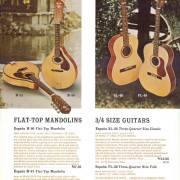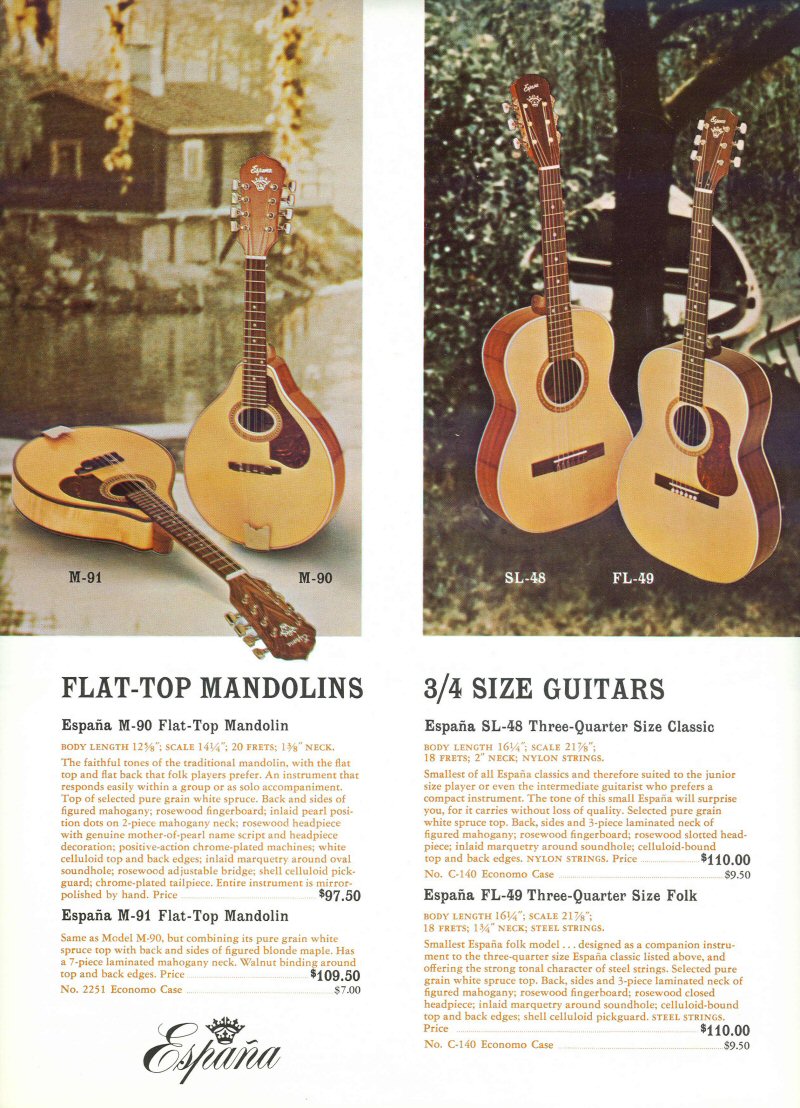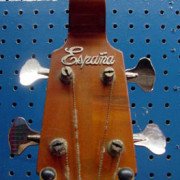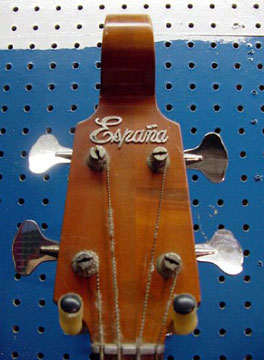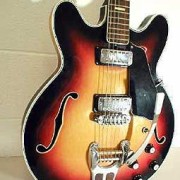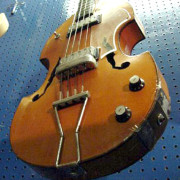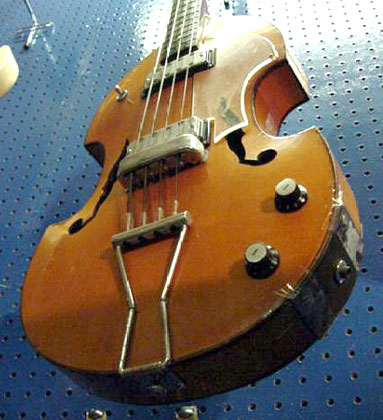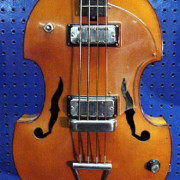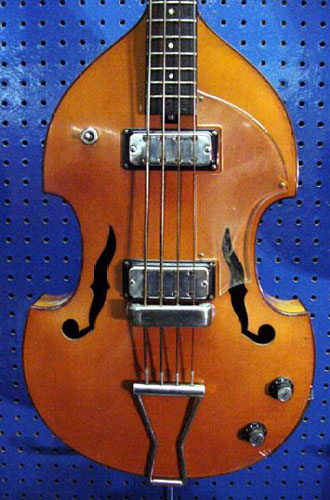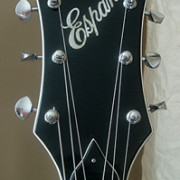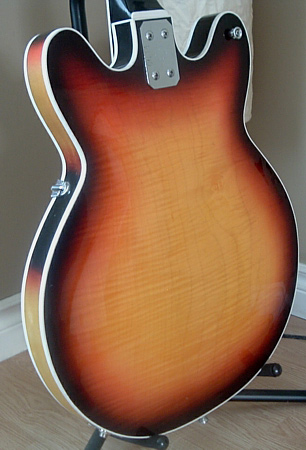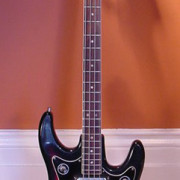España – Buegeleisen & Jacobson
by Jack Marchal
España was a brand name used by Buegeleisen & Jacobsonof New York City. This company imported instruments made overseas under its specifications (or meeting its specs) and marketed through various wholesalers or distributors in North America. In its position B&J did not have to care about neither manufacturing nor after-sale warranty, it was just a buy and sell business. Key to success was a long established fame (the company was founded in 1901 or so), a carefully selected product range and a clever marketing policy that focussed on a few proprietary trademarks.
As far as electric guitars are concerned Japanese-made instruments were sorted between the Winston (entry level) and Kent (medium to pretty good quality) brands, regardless of the actual manufacturers (Guyatone, Teisco, Kawai…).European guitars were gathered under the brandname España, first used in the years 1961-1967 for Swedish-made classical guitars supplied by Hagström (more about it). B&J and Hagström had been in relationship as soon as 1932, as Hagström just started production of accordions and was already looking for opportunities to export to the USA.
The name Espana was an obvious reply to the also N.Y.C.-based Hershman Musical Instruments Co. that was by then enjoying a huge success with acoustic guitars made in Gothenburg by Herman Carlsson AB (a.k.a. Levin) and sold in the U.S. under the fake Spanish name Goya. B&J took advantage of the high repute they had granted to Swedish-made guitars and choosed a name that sounded even more Spanish. Sales were soon buoyant, B&J complained they didn’t got enough of those guitars to satisfy demand, so instruments from Finland were also enlisted to enlarge the España section in the B&J catalog. There is no much doubt that Hagström helped to establish the link to this additional sourcing.
In the 60’s second half Buegeleisen & Jacobson also applied the España brand to ES-335 copies from Italy (made by Crucianelly) and Finland, the Finnish ones being distinguished by their glued-in neck and a crown logo. Other than that both ranges were pretty similar. Wether Italian or Finnish supplies were first to be imported in the U.S. ist still unclear. España electrics from Finland are more frequently shown in B&J catalogs and ads, but on the vintage market the Crucianelli versions are at least six times as many. In terms of specs they do not show any difference with those wearing a Élite, Crucianelli or Tonemaster logo.
España era un marchio usato da un’azienda di New York, Buegeleisen & Jacobson, che importava strumenti costruiti oltre-oceano secondo le sue specifiche e rivenduti a diversi grossisti e distributori nord-americani. Posizionata com’era la B&J non si impegnava né nella produzione né nella garanzia post-vendita, si limitava a comprare e rivendere. Il suo successo era fondato su una consolidata reputazione (la ditta era stata creata nel 1901 circa), una gamma di prodotti selezionati con cura, e un’abile politica di marketing centrata sui proprii marchi.
Per le chitarre elettriche, quelle di origine nipponica erano divise fra i brand Winston (strumenti economici) e Kent (qualità da media a piuttosto buona), poco importava chi fosse il vero produttore (Guyatone, Teisco, Kawai…).
Le chitarre europee erano radunate sotto il marchio España, inizialmente impiegato negli anni 1961-67 per le chitarre classiche di produzione svedese fornite da Hagström. B&J e Hagström erano partner già nel 1932, quando Hagström cominciava a produrre fisarmoniche e a preoccuparsi di esportarle in USA.
La denominazione España era chiaramente una risposta alla ditta Hershman Musical Instruments, anch’essa di New York, che allora godeva di un gran successo con le chitarre acustiche fatte a Göteborg da Herman Carlsson AB (alias Levin) e vendute in USA con il nome pseudo-spagnolo Goya. B&J approfittò della buonissima fama che esse avevano dato alle chitarre svedesi, e scelse per le sue un nome ancora più iberico. Le vendite furono subito floride, e presto B&J si dovette lamentare di non averne abbastanza per soddisfare la domanda, perciò strumenti dalla Finlandia furono reclutati per rinforzare il capitolo España del catalogo B&J. Non c’è dubbio che Hagström aiutò a stabilire la relazione con questa fonte supplementare.
Nella seconda meta del decennio il marchio España venne anche dato da Buegeleisen & Jacobson a copie ES-335 fatte in Italia (da Crucianelli) e in Finlandia, quest’ulltime erano distinte dal manico incollato e da un logo a forma di corona. A parte questo, le due linee erano assai simili. Non si sa tra le forniture finniche e quelle italiane quali furono le prime importate in USA. Le elettriche España finlandesi prevalgono nei cataloghi e nella pubblicità B&J, ma sul mercato del vintage le versioni Crucianelli sono almeno sei volte più numerose delle altre. In termini di specifiche non si nota la minima differenza con quelle marcate Élite, Crucianelli o Tonemaster.





